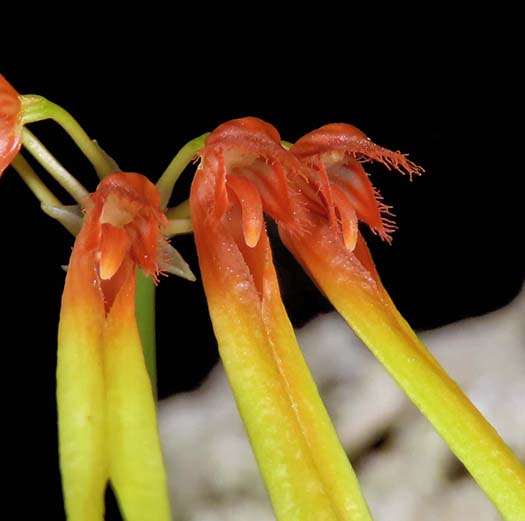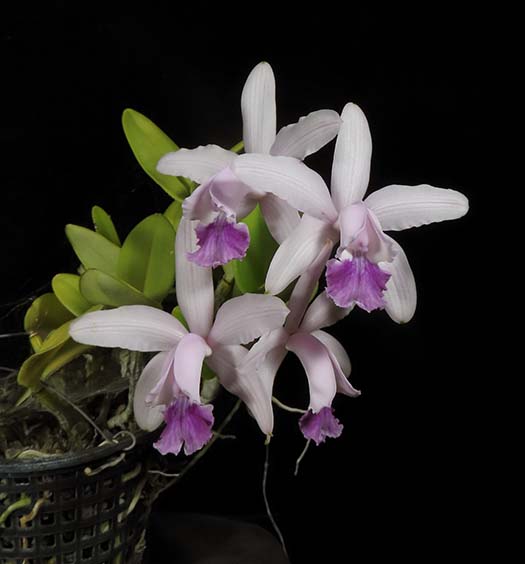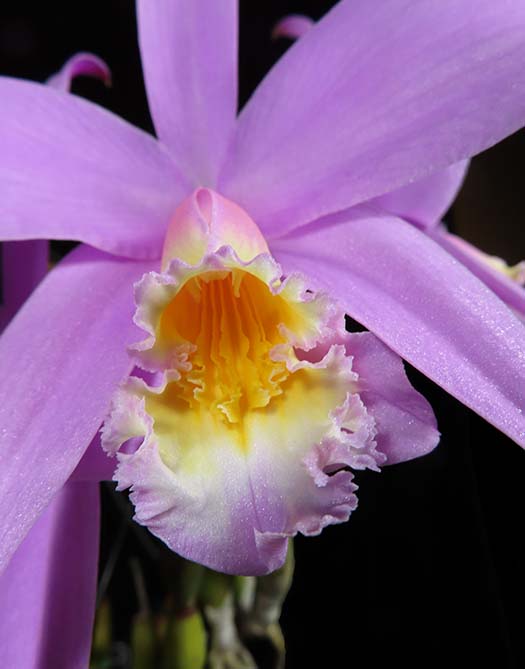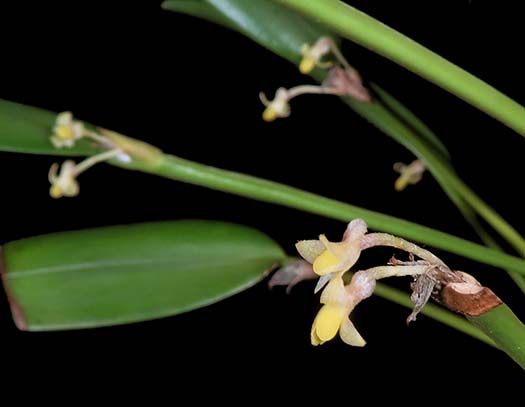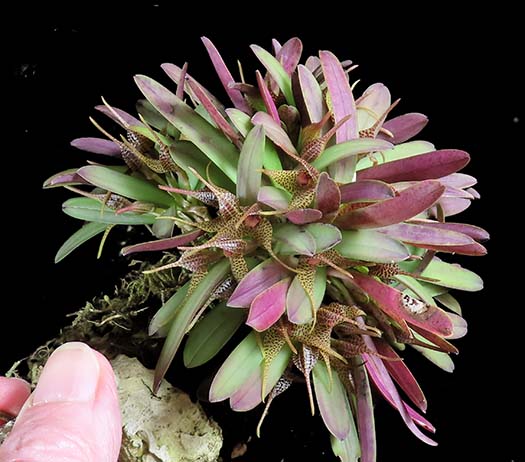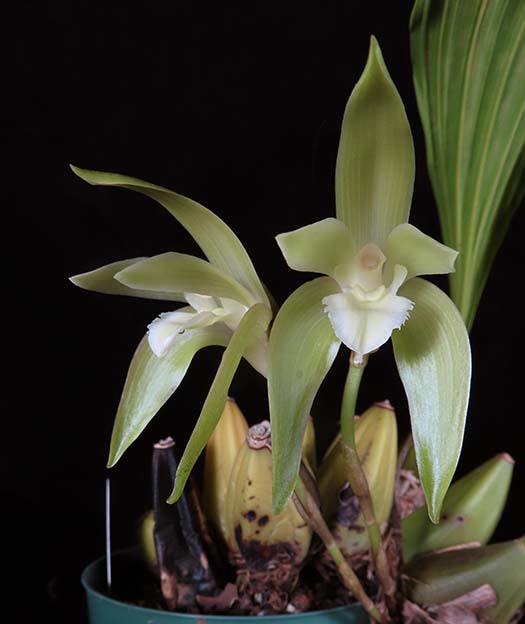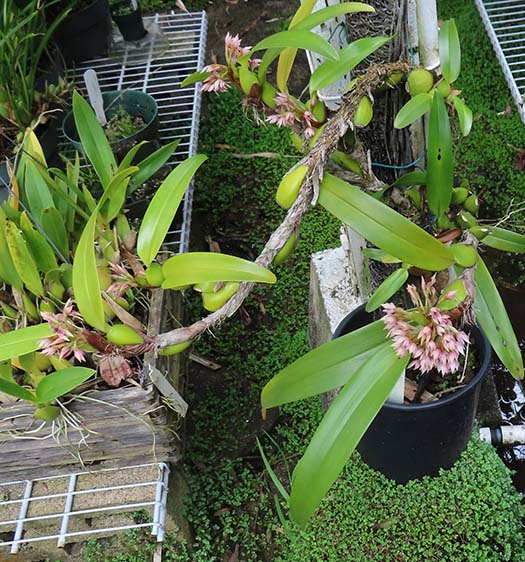May 2024
From Kurt Shanebeck:
|
|
Outdoors coastal, north of Los Angeles: |
|
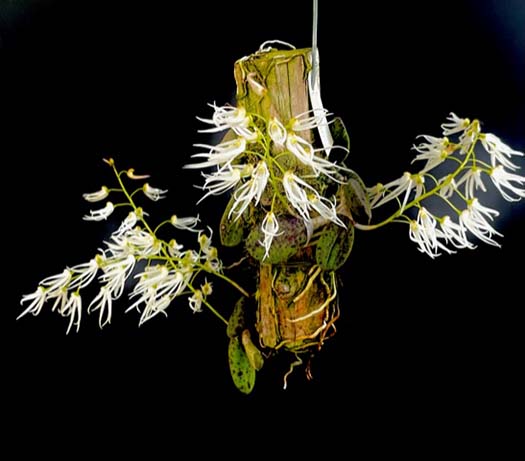 Dendrobium linguiformeAn Australian epiphyte or lithophyte with a creeping habit and tongue shaped leaves. Growing mounted with bright light. |
|
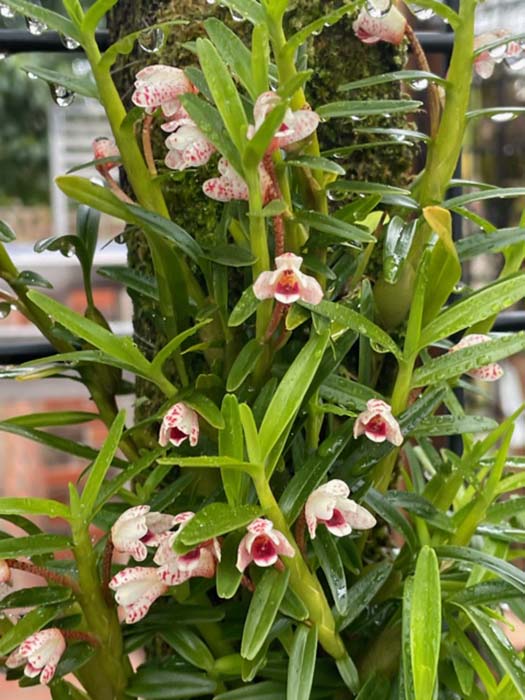
Maxillaria arbusculaTerrestrial species from Peru and Ecuador at elevations of 1500-3100m. |

Mediocalcar pygmaeumNative to montane forests in New Guinea at elevations of 1200-2800m. Growing mounted with bright light. |

Oncidium ghiesbrechtianaEpiphyte or lithophyte native to Mexico at elevations of 1400-2300m. Growing mounted with bright light. |
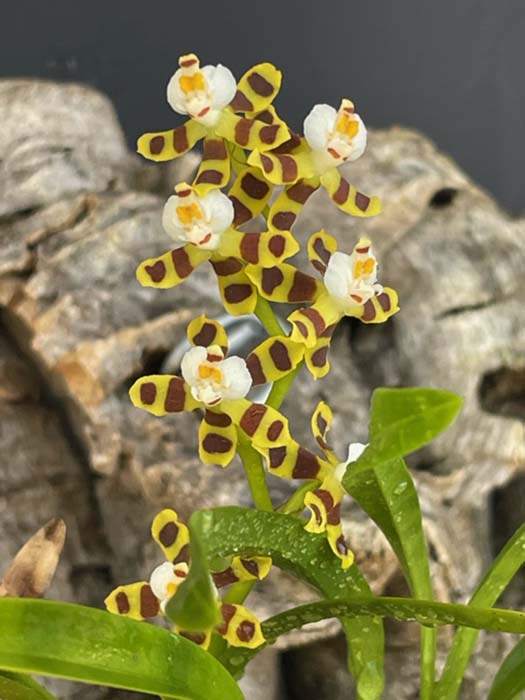
Oncidium tigroidesPeruvian epiphyte found at elevations around 1800m. Growing mounted and shady. |
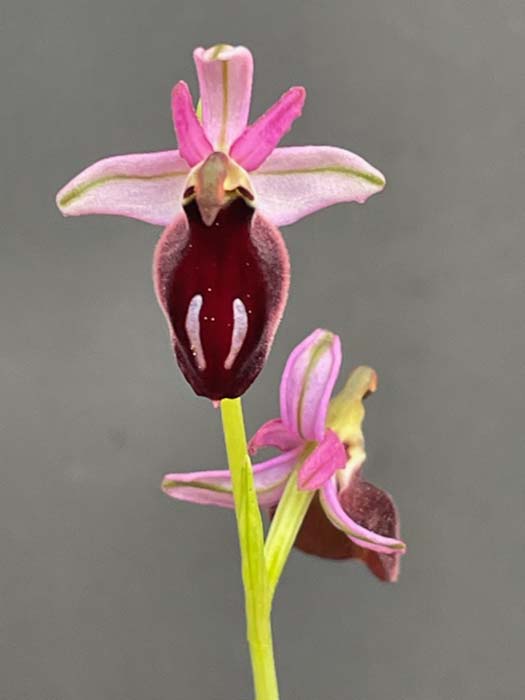
Ophrys ferrum-equinumTerrestrial species native to Greece and Turkey, Growing potted with bright light. |

Polystachya ottonianaNative to Southern Africa where it grows primarily as an epiphyte. Growing mounted and shady. |
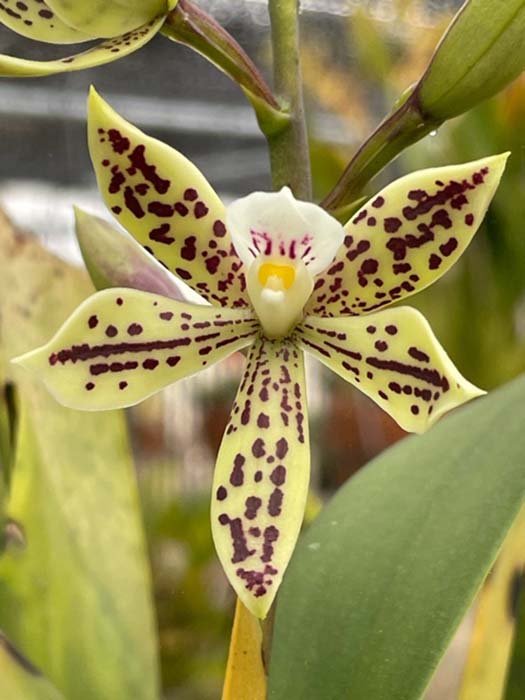
Prosthechea bueraremensisGrowing potted with bright light, |
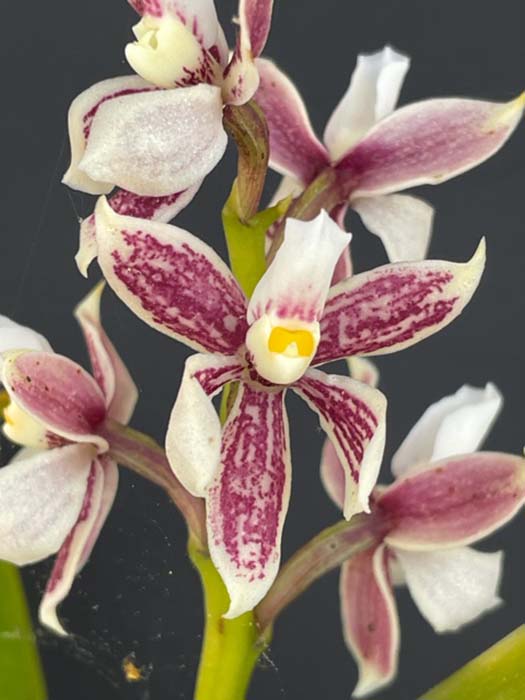
Prosthechea faresianaLithophyte from Brazil at elevations of 1000-1500m. Growing mounted with bright light. |
Growing indoors under LED lights |
|
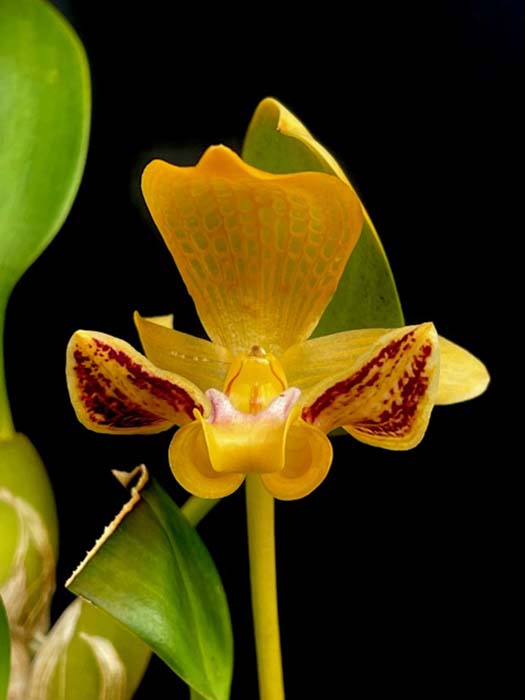 |
Bulbophyllum deariiNative to Borneo, Malaysia and the Phillipines, primarily growing as an epiphyte at elevations of 700-1200m. Growing potted under bright light. |
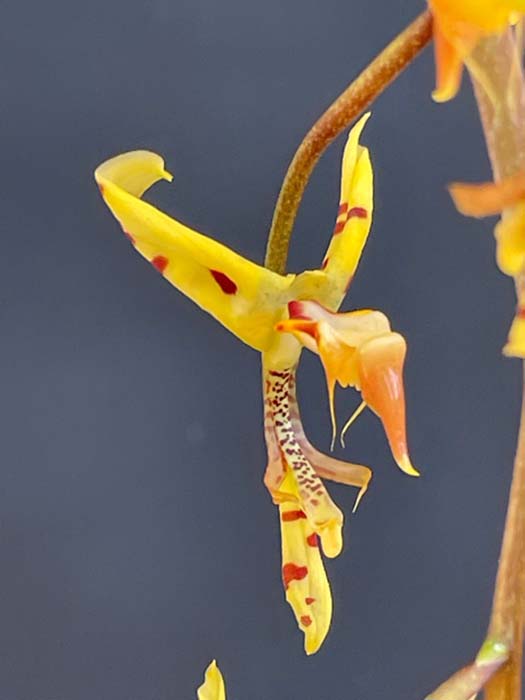 |
 |
Gongora fulvaNative to Columbia growing as an epiphyte at elevations of 400-900m/ Growing potted with moderate light. |
|
.jpeg) |
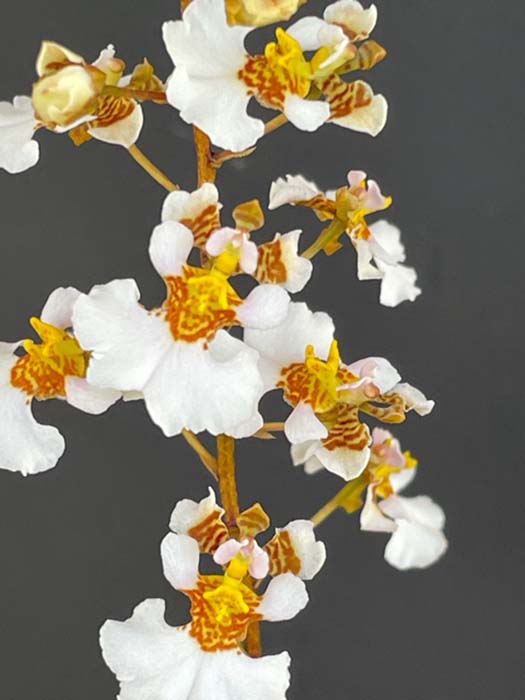 |
Tolumnia variegataA small Caribbean epiphyte found at elevations to 700m. Growing mounted under bright light. |
|
From Chris Ehrler:
|
|
California Central Coast |
|
 Cymbidium schroederiA cool growing plant in humus at elevations of 1,350 to 1,700 meters. This orchid is growing in a plastic pot filled with a mixture of bark and perlite. Growing outside under a lath shade structure. |
|
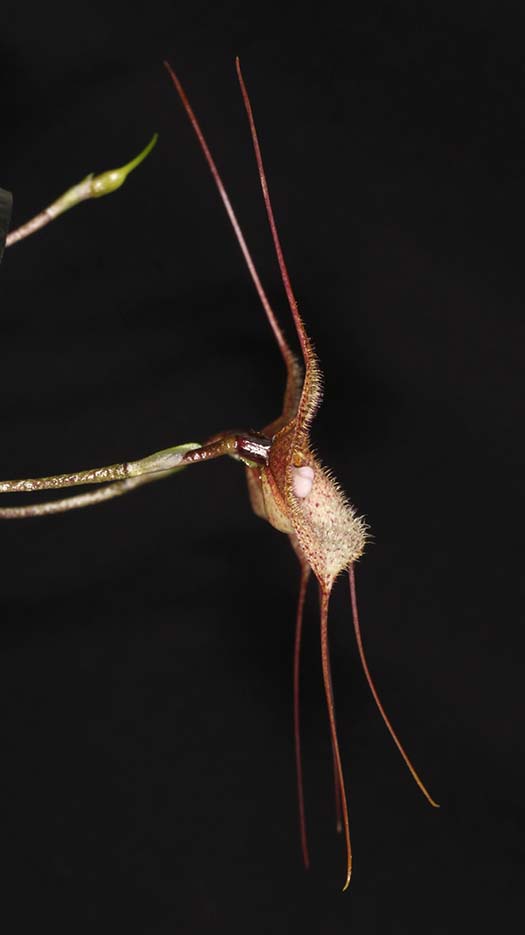
Dracula janetiaeA cool growing epip[hyte found in Peru and possibly in Ecuador at elevations around 1,700 meters. This orchid is growing in a mesh pot filled with sphagnum moss that is hanging in a cool greenhouse.
|
 |
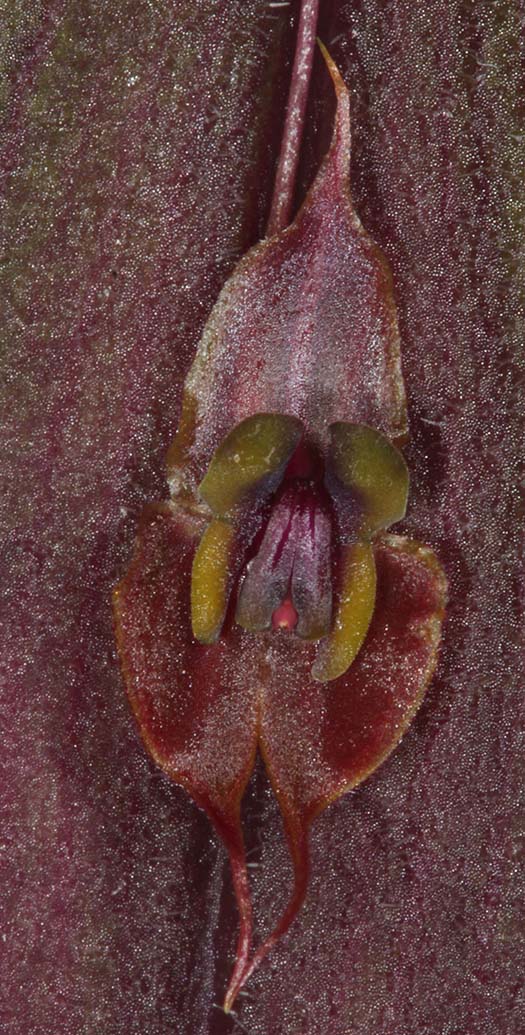 |
|
Lepanthes gargoylaA warm to cool growing epiphyte growing in Ecuador at elevations around 900 to 1,300 meters. This orchid is growing on a piece of wood with some sphagnum moss on the roots. The mount is hanging in a cool greenhouse. |
|
Masdevallia bennettiiThe literature states this is a warm growing epiphyte found in central Peru at elevations around 780 meters. But this plant is growing well in a cool greenhouse where winter night temperatures can be as low at 40F. Growing in a clay pot filled with sphagnum moss. |
|
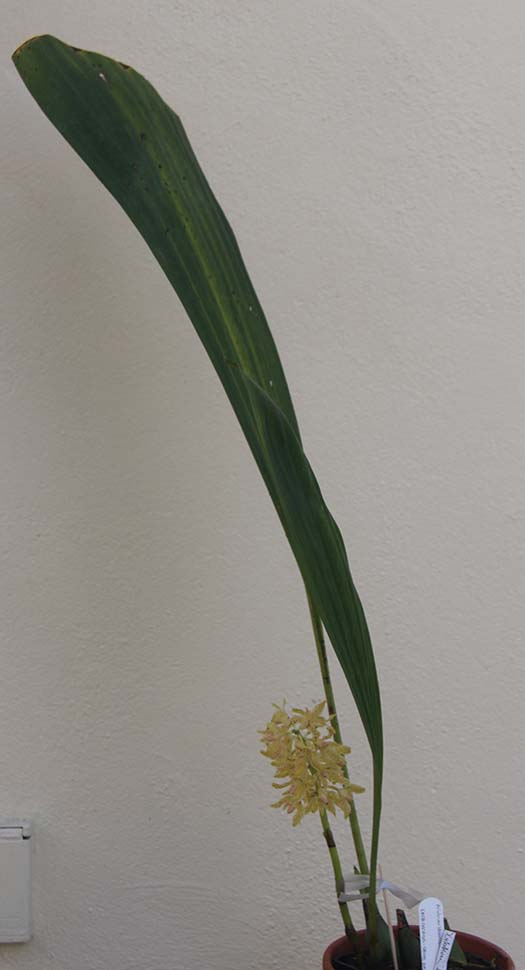
Xylobium leontoglossumA cool to cold growing epiphyte and occasional terrestrial found in Venezuela, Colombia, Ecuador, and Peru at elevations around 2,000 meters. This orchid is growing in a clay pot filled with a bark and lava rock mixture which is placed in a cool greenhouse. Leaves are about 3 feet tall. |
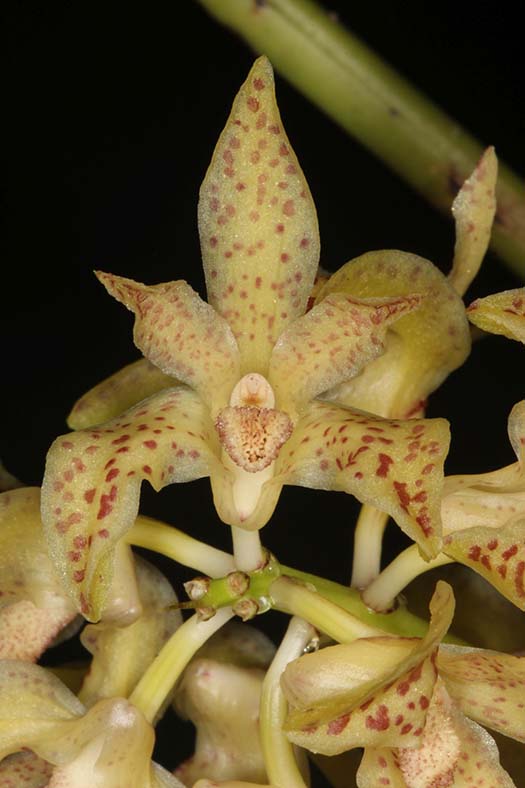 |
 |
|
Dracula barrowii 'Kathy' AM/AOSA cool to cold growing epiphyte which was grown and described from a plant in England that came from Peru, although this species has not been found again in Peru. This orchid is growing in a cool greenhouse in a mesh pot filled with sphagnum moss. |
|
Masdevallia lappiferaA cool growing epiphyte found at an elevation of 1,200 meters in Ecuador. This orchid is growing in a cool greenhouse in a clay pot filled with sphagnum moss. |
|
 Maxillaria minutaOrchids.org's states that the currently accepted name is M. pumila. M. pumila is described in orchidspecies.com as a hot growing epiphyte occurring in Brazil and Guianas. But the orchid in the photo is growing and flowering well in a cool greenhouse. Mounted on a piece of cork oak with some moss on the roots. |
|
 |
|
Pleurothallis flexuosaA hot to cool growing epiphyte found at elevations of 350 to 1900 meters in Venezuela, Colombia, Ecuador, Peru, and Bolivia. Growing in a mesh pot filled with a mixture of bark and lava rock which is in a cool greenhouse. (August) |
|
From Arnold Markman:
|
|
Intermediate Greenhouse, coastal San Diego area
|
|
Vanda nana |
|
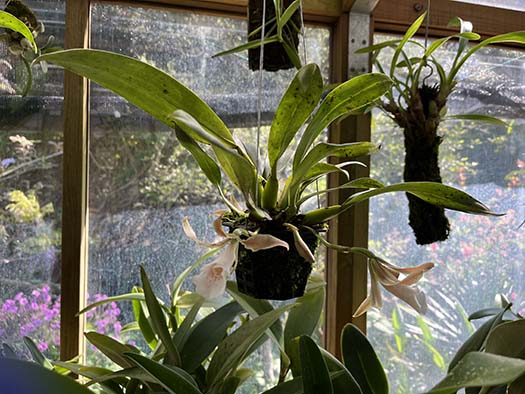 Trichopilia tortilisWater every 2-3 days |
|
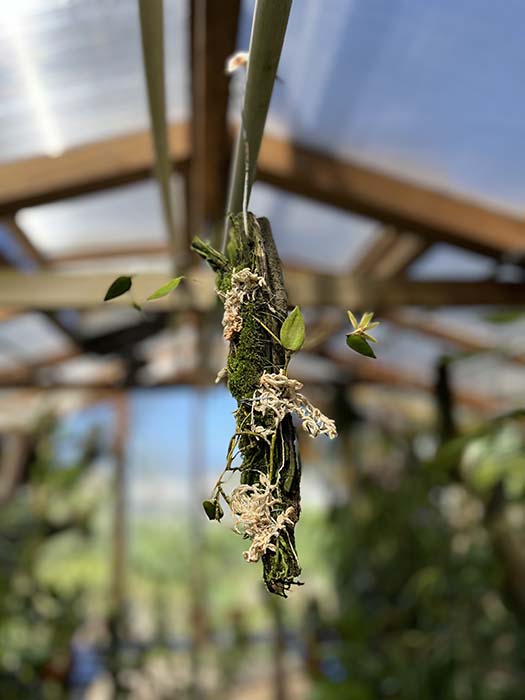 |
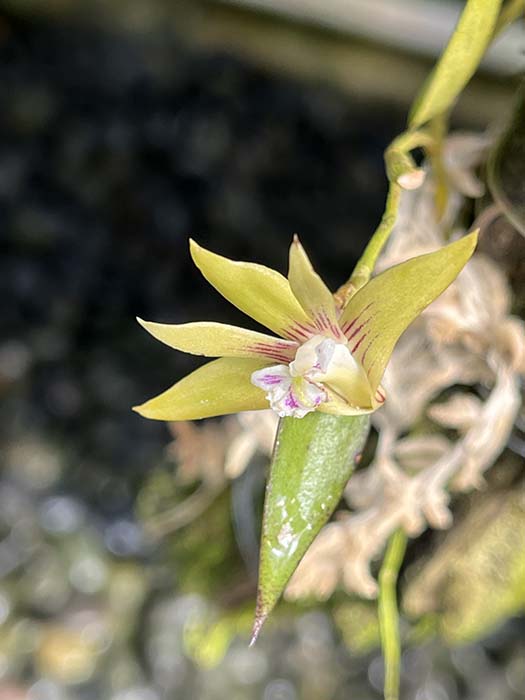 |
Dendrobium pugioniformeDoesn’t seem to be growing much but here is a flower. I followed the”Rock Lily Man’s” advice on the internet and attached this plant at the nodes hoping it will branch. |
|
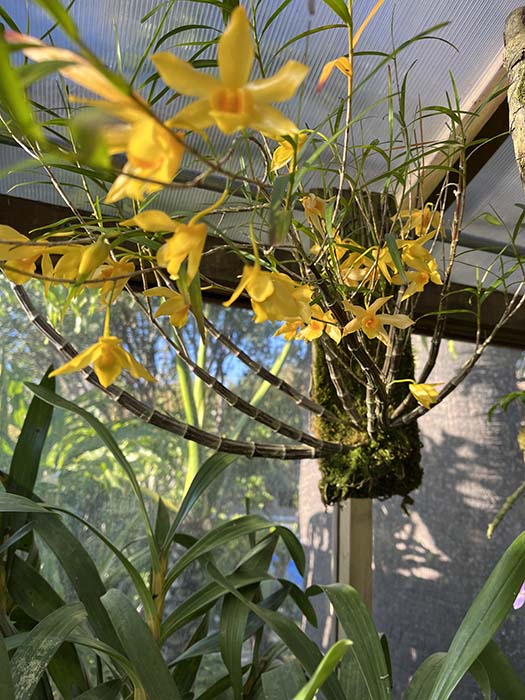 Dendrobium hancockii |
|
 |
Den loddigesiiNot watered from November to mid-February. It’s a challenge to mimic the “humid, mossy, mixed and coniferous forests at elevations of 1000 to 1500 meters “ in SE Asias that the IOSPE describes. I imagined that they needed frequent misting but held off on watering. This is the best year yet! |
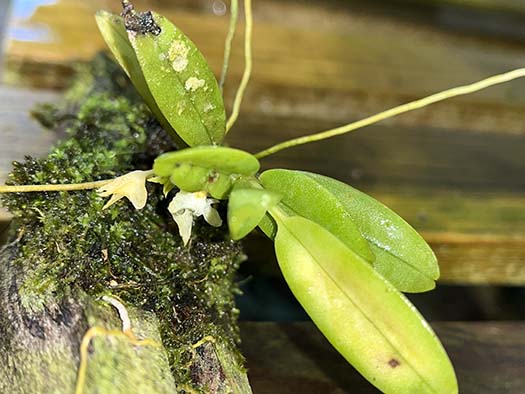 Thrixspermum sp. from BorneoFirst time it’s flowered for me. |
 |
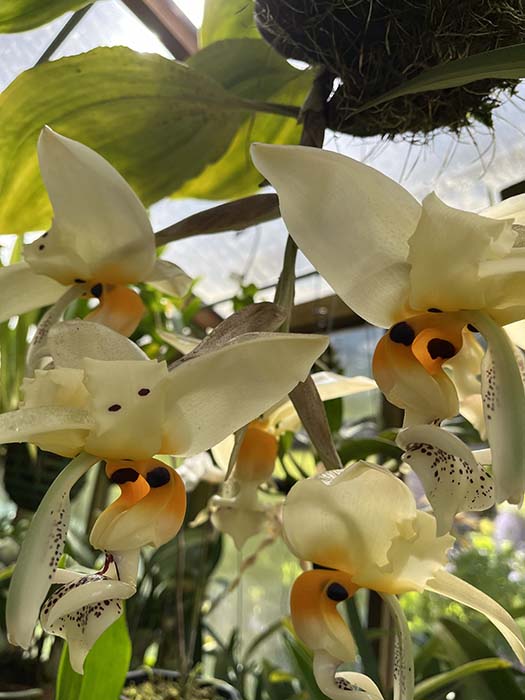 |
|
Stanhopea oculataWow! |
|
 |
 |
Platystele portillaeThis is the best I could do with an iPhone, flowers only about 1 mm. Grown hanging. |
|
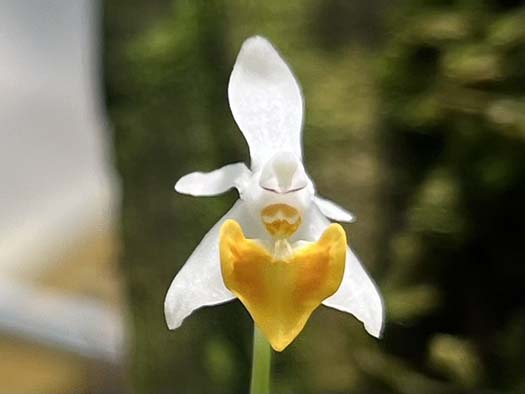 Phalaenopsis malipoensis |
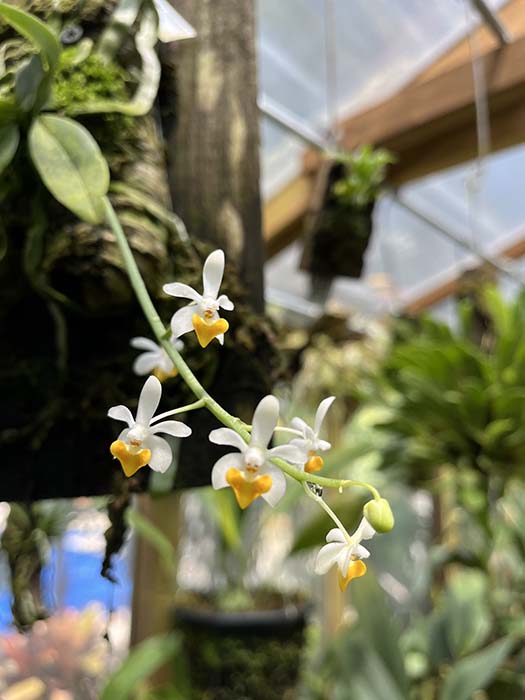 |
 |
|
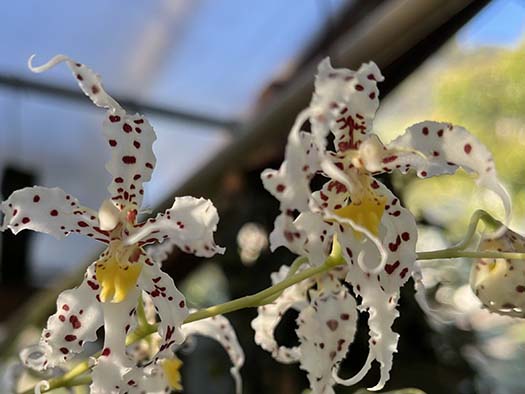 |
|
From Scott McGregor:All orchids grown outdoors, coastal southern California |
|
Masdevallia veitchiana 'Prince de Galle' AM/AOSFor some reason, it seems that Masdevallias don’t like me and I’ve had trouble growing them, despite lots of happy Restrepias, Draculas, Porroglossums, etc. Kay Klausing suggested that some clones do much better than others and I got some M. veitchiana and M. coccinea clones from him to try. A year has gone by, all the new plants are (still) happy and starting to send up spikes. This is the first to bloom—love the color and size! |
|
Thelymitra glaucophylla x crinitaHard to find a sunny morning this month—the blue flowers only open on perfectly clear sunny days. |
|
Thelymitra glaucophylla x grandifloraLarger blue flowers from grandiflora |
|
From Roberta Fox:Coastal southern California |
|
Outside in the Back Yard: |
|
|
|
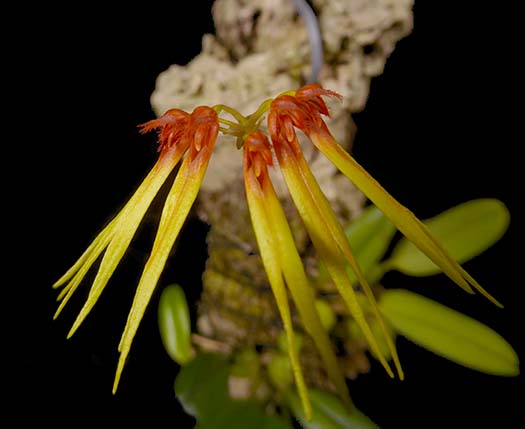
Bulbophyllum hirundinisFrom Vietnam and Taiwan, it grows over a range of elevations from 500 m to 3000 m. So it grows cool, but could grow warm too. Since it grows mounted, it clearly also handles a bit of drying though it gets daily watering. |
|
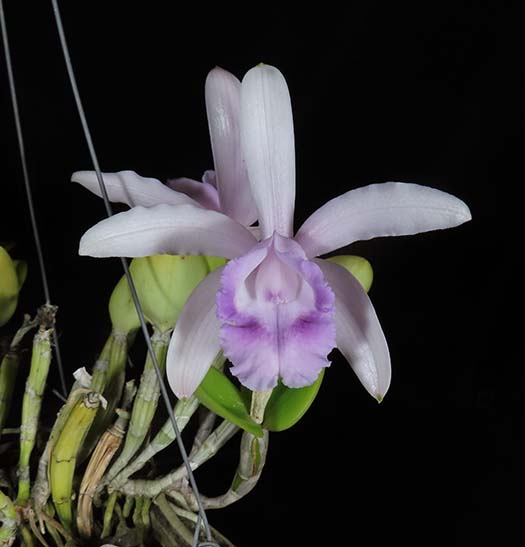 |
|
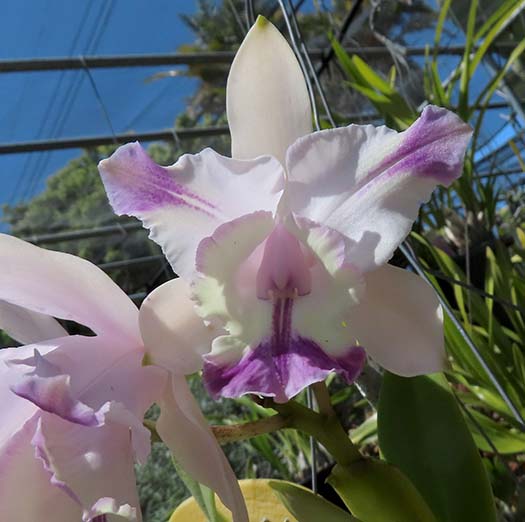 |
|

Cattleya schroederaeDelicate light pink with the brilliant egg-yolk in the throat. Flowers are about 7 inches across. Native to Colombia at elevations 1400-1600 m. |
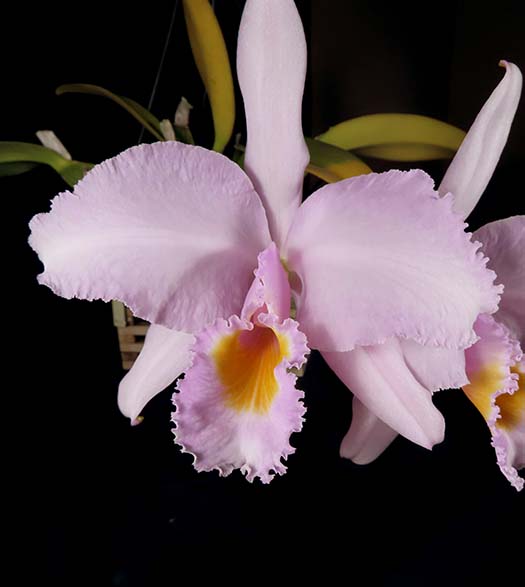 |
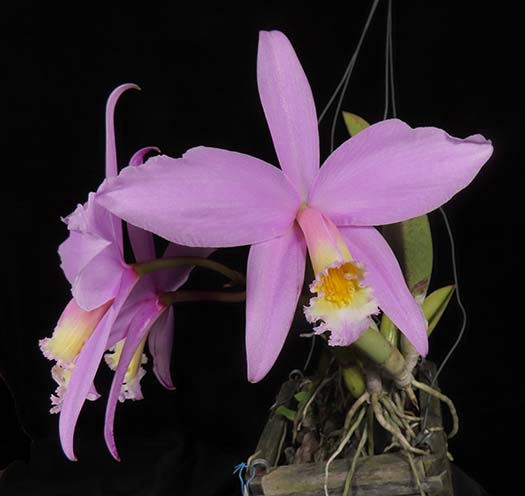
Cattleya (Laelia) jongheanaFlowers range from around 5 inches to more than 6 inches across, on plants that are about the same size. So excellent flower-to-plant ratio. Flowers are also very flat, so the presentation is exquisite. From southeastern Brazil, elevations 1300-1600 m. It thrives in the cool coastal climate. |
|
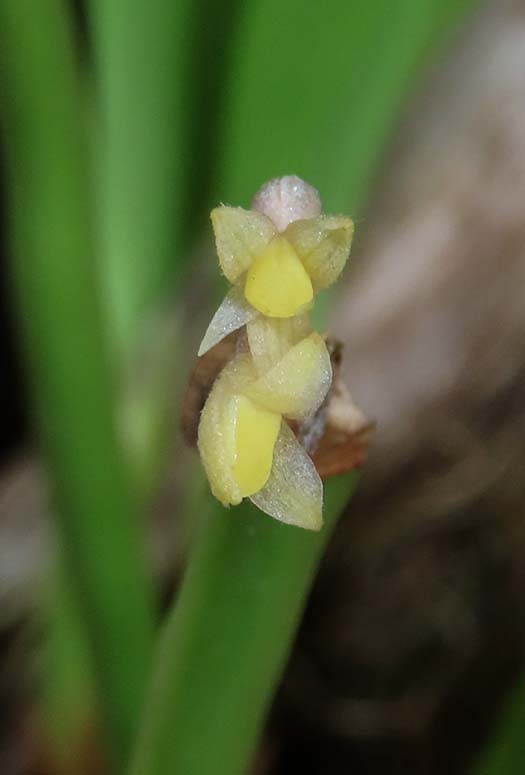 |
|
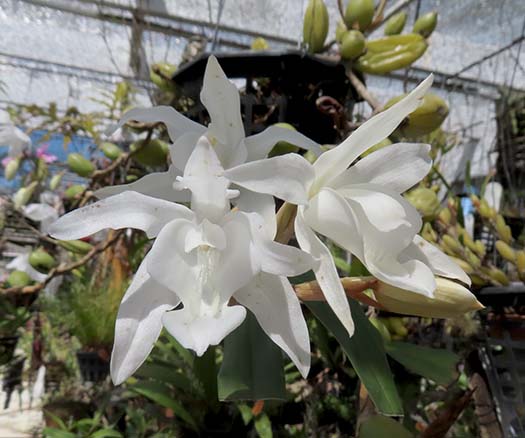
Coelogyne cristata f. albaThe plant doesn't seem to like to stay in its basket, a bit rangy. But it is a lovely flower. From a wide geographical range in the Himalayas and southeast Asia. |
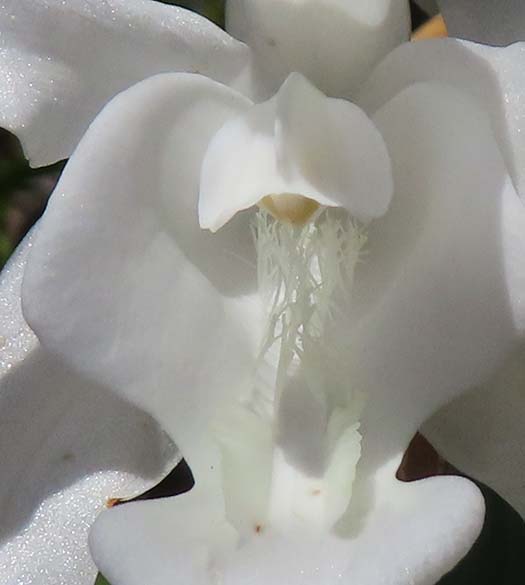 |
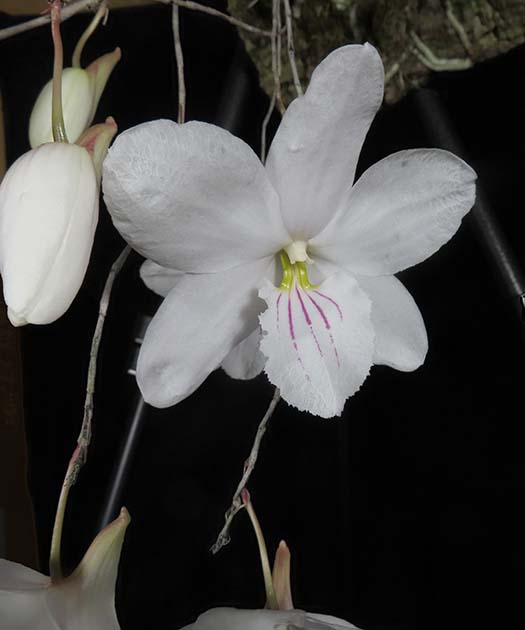
Dendrobium papilioThis is the large-flower form, which sometimes is less floriferous than the small-flower form. But this one is the best of both - large flowers and also lots of them. The flowers emerge mostly on leafless canes that are wire-thin. Imagine these flowers floating in the breeze among jungle growth, seemingly attatched to nothing. Native to the Philppines, elevations 1400-2300 m. |
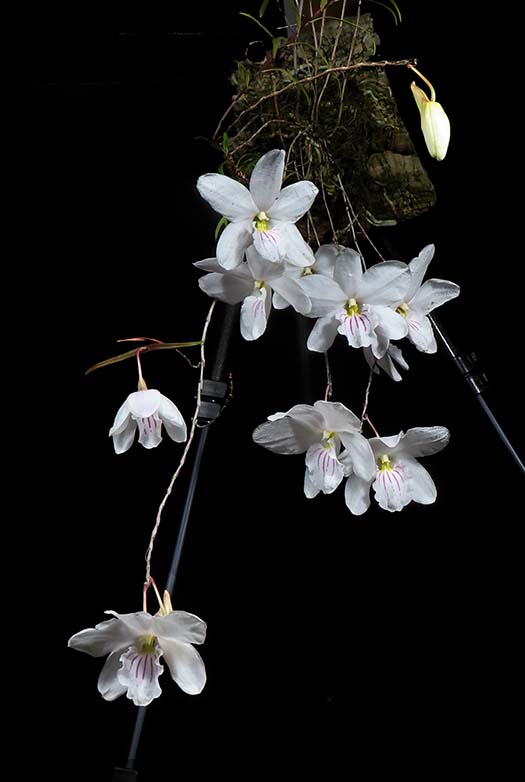 |
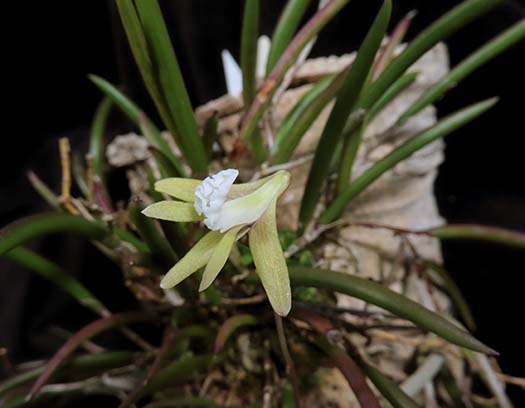 Dendrobium striolatumAustralian native. |
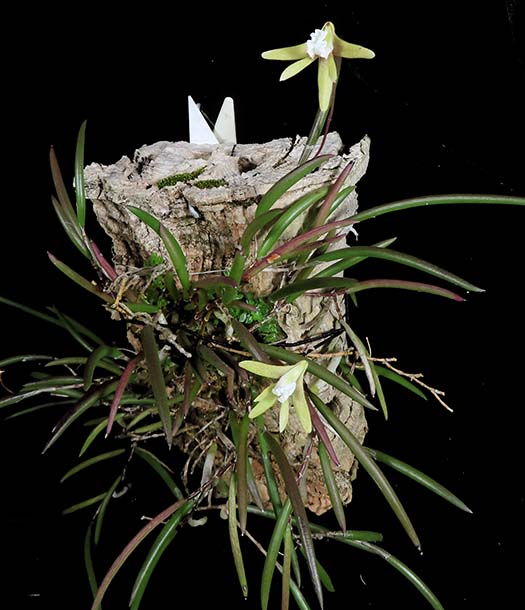 |

Dendrobium toressaeAnother Australian species, growing at a range of latitudes and elevations. It forms a mat of succulent leaves, with these tiny flowers. |
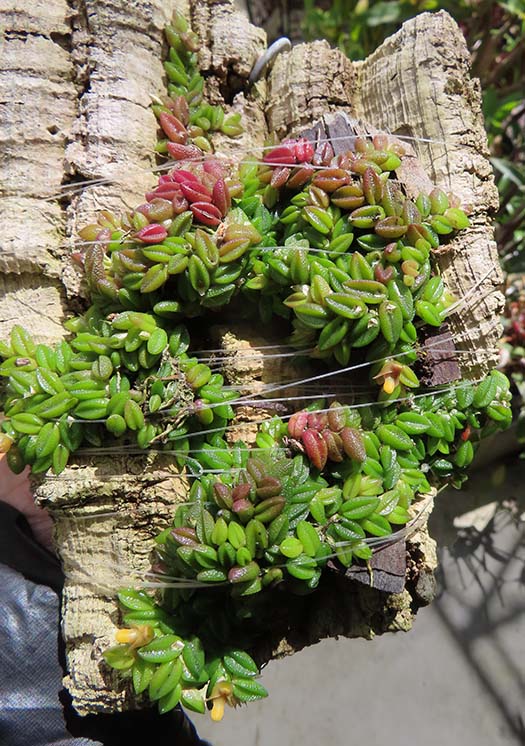 |
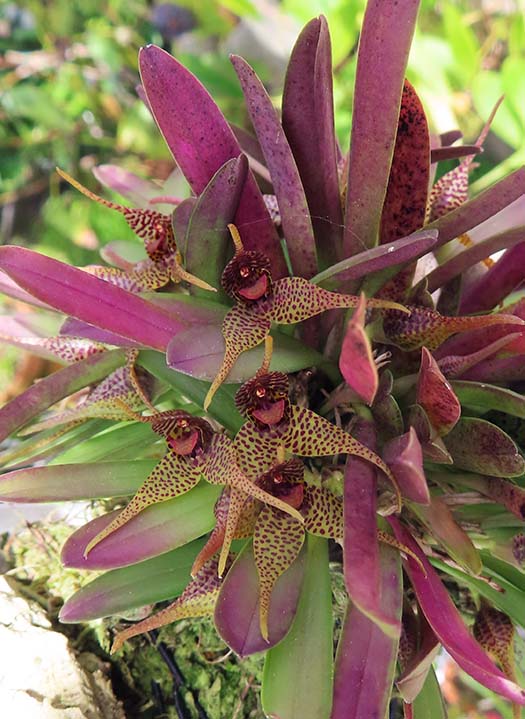 |
|
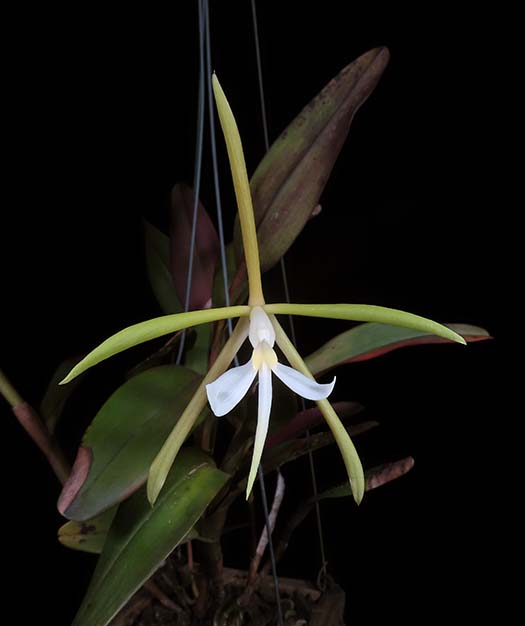 |
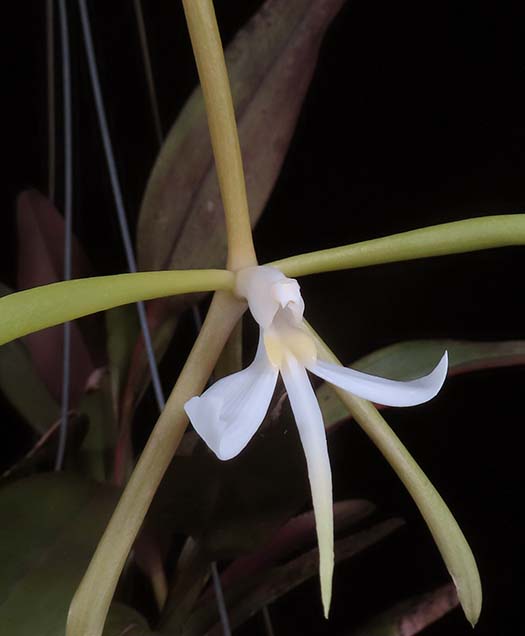 |
Epidendrum nocturnumNative to South America on both sides of the Andes, at a range of elevations. I saw these in Ecuador at around 1000-1200 m, and also in Brazil, along the Rio Negro in the Amazon basin. It does fine in my back yard. |
|
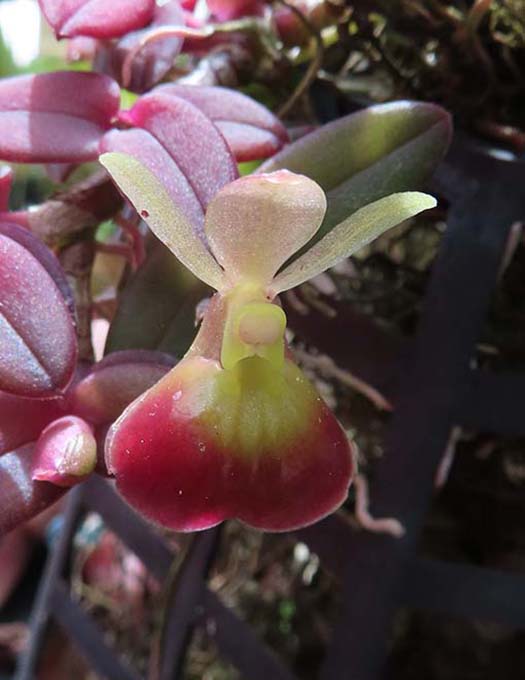
Epidendrum porpaxThis species has gone under several other genus names but it's back to Epidendrum. It tends to form mats. I am growing it on top of an inverted plastic basket. Flowers have heavy substance. |
|
 Dracula mantissaLots of small flowers, but they open at different times, so never quite got a flush bloom. |
 |
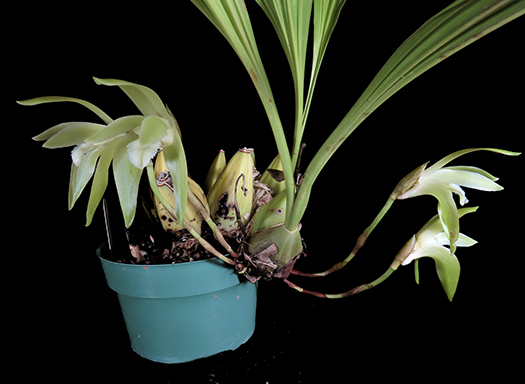 Sudamerlycaste (Ida) ciliataColombia, Ecuadur, Peru, Venezuela. These "South American Lycastes" tend to nod downward, the larger, rounder Lycastes are mostly from Central America. |
|
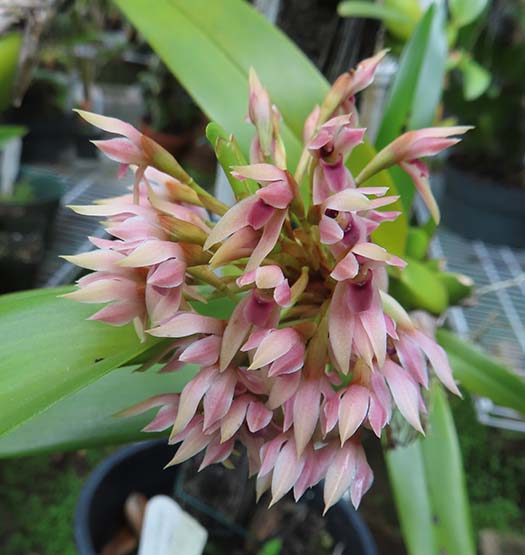 |
|
Maxillaria densaWith these clusters of llowers, it lives up to its name. Growth habit is rather unruly, but it's vigorous. Southern Mexico into Central America. |
|

Mediocalcar versteegiiThis species is a very vigorous rambler. Native to New Guinea and surrounding islands. I'm not at all sure that this isn't actually Med. biflorum. The descriptions are rather ambiguous. I do love the little "candy corn" flowers. |
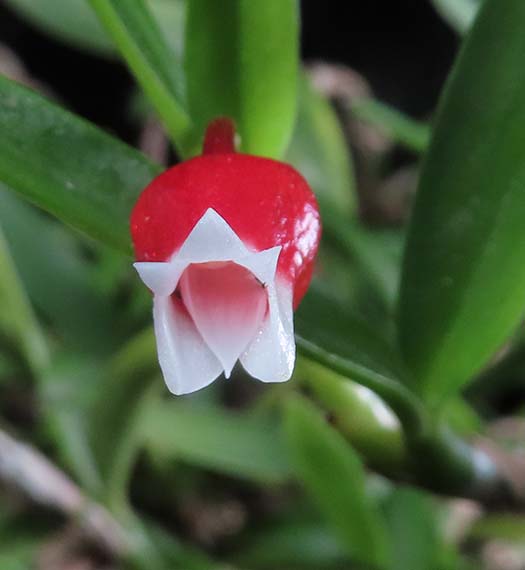 |
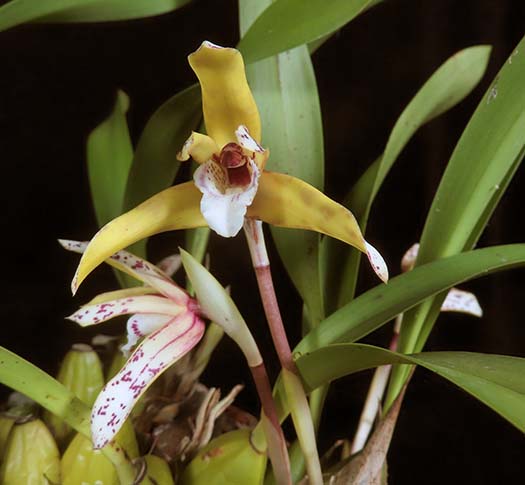
Maxillaria pictaOne of the most commonly-grown Maxillarias in southern Californai. The speckled buds open to reveal bright yellow flowers on the inside. |
|
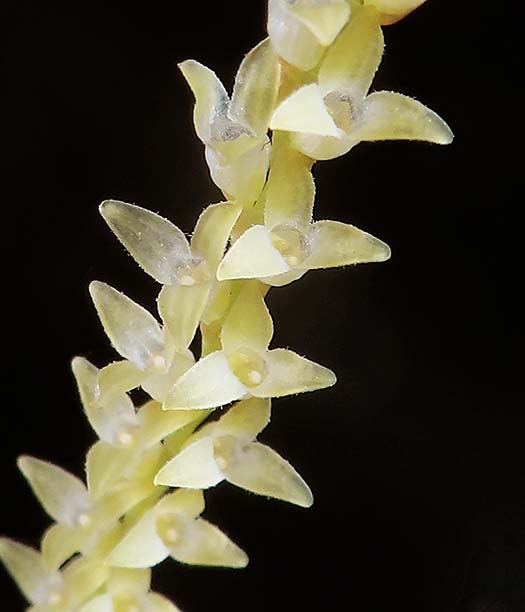 |
|
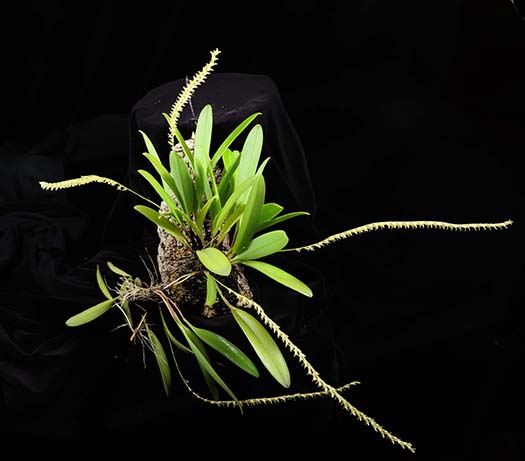 |
|
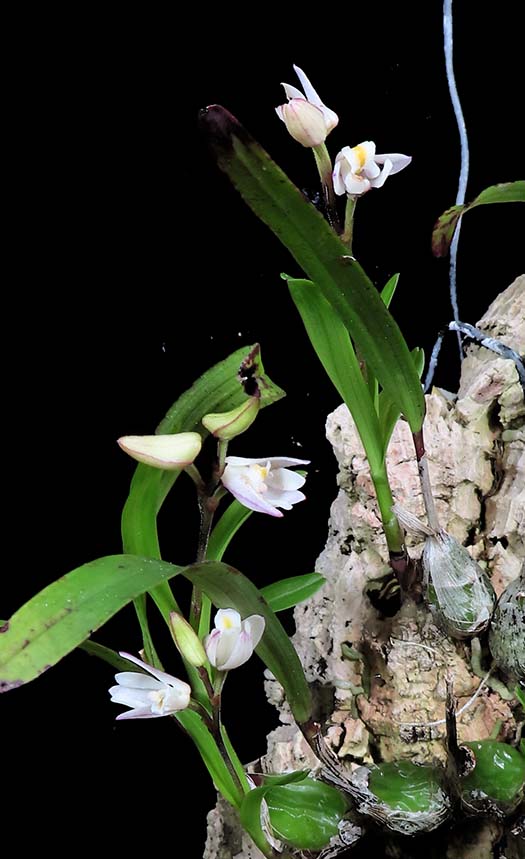
Polystachya ottonianaNative to southern Africa, elevations 800-1600 m. One of the cooler-growing species of the genus. Note the non-resupinate (lip on top) flowers. |
 |
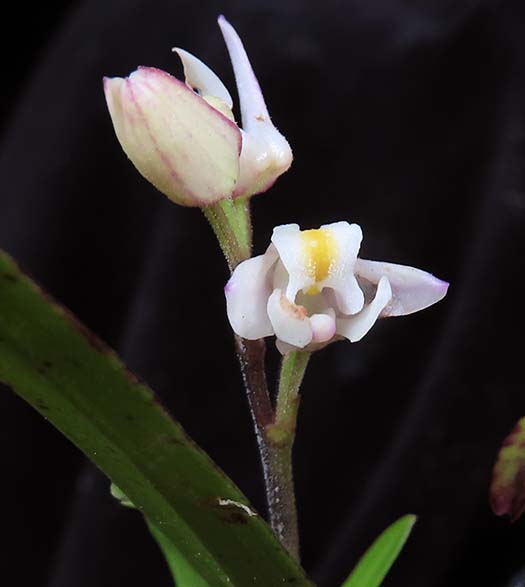 |
|
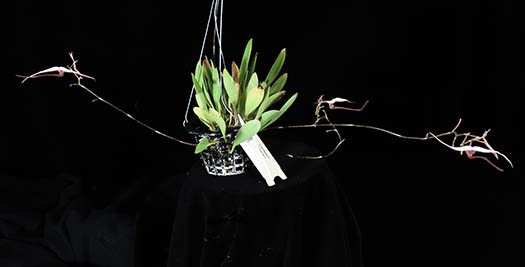
Scaphosepalum gibberosumThis is a sequential bloomer that I have shown before. This is the first time that I have had 3 flowers open at the same time. |
 |
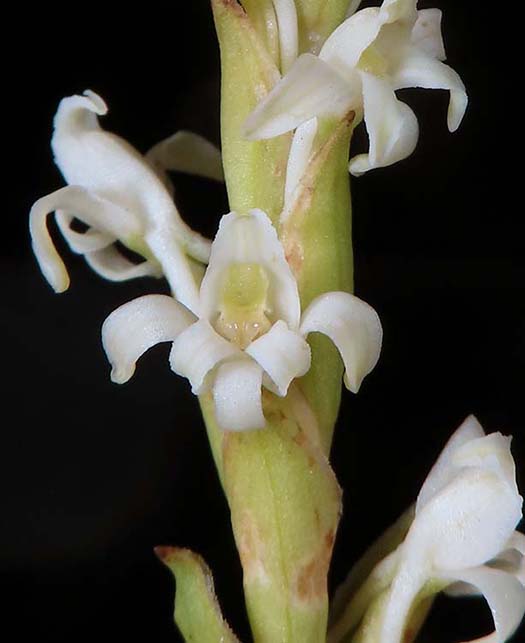 Satyrium stenopetalumA South African terrestrial from a Mediterranean climate. |
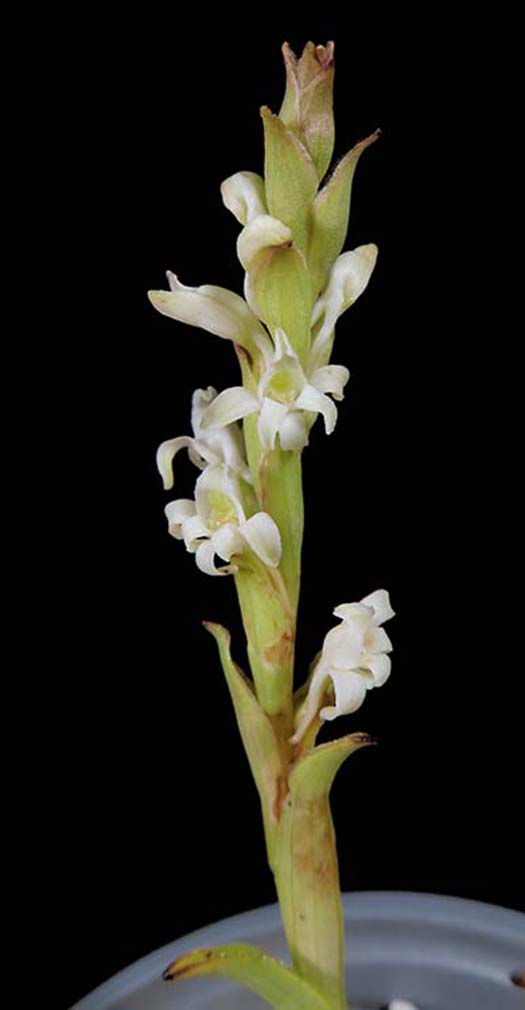 |
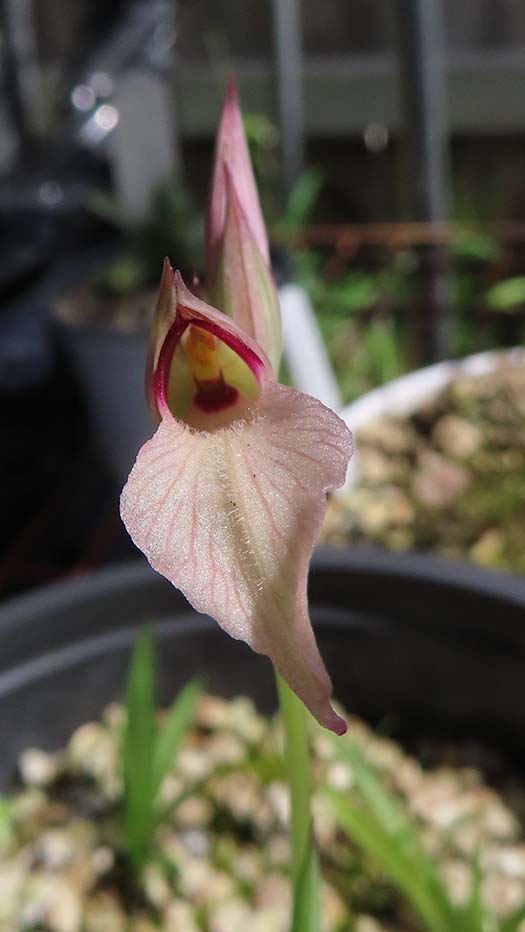
Serapias linguaWidea area of southern Europe, North Africa, and the Middle East |
|
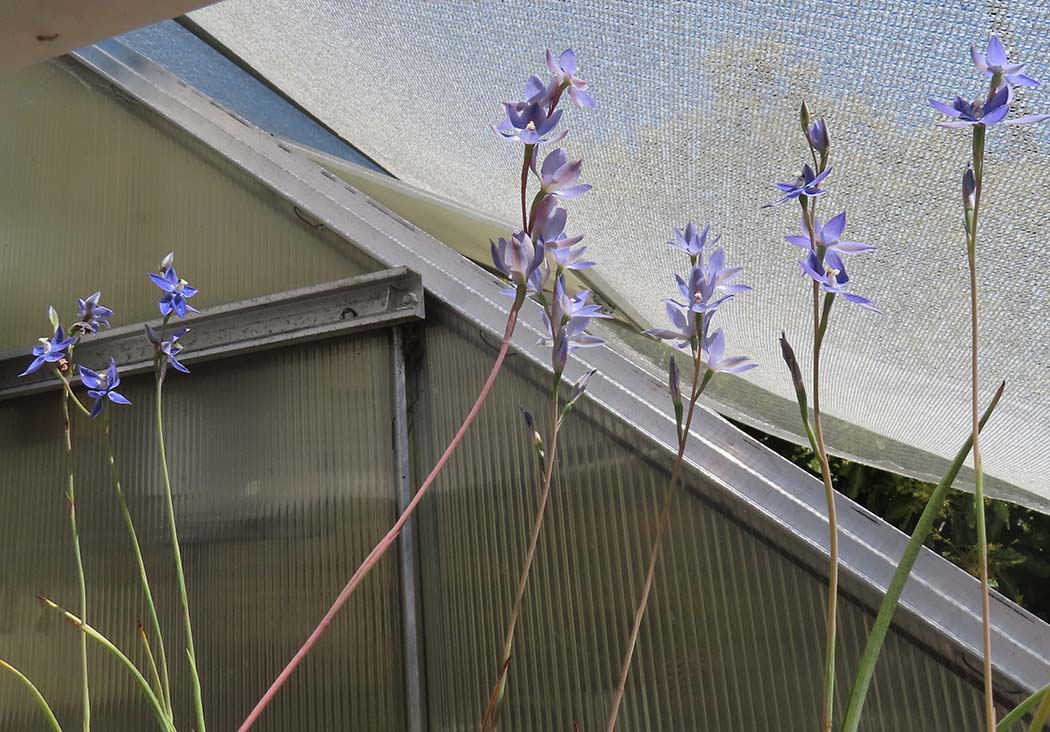 |
|
Blue ThelymitrasWe finally got some sunny days, and the blue Thelymitras put on a show. On overcast days they all close up, waiting for bright sun. While there are starting to be some AOS awards for other Mediterranean-climate terrestrials, there are hardly any for Thelymitras (I found just one on the AOS website). Their habit of closing up in less than the brightest sunshine doesn't work well with the logistics of judging centers. |
|
 |
 |
Thelymitra glaucophylla 'Adelaide' |
|
 |
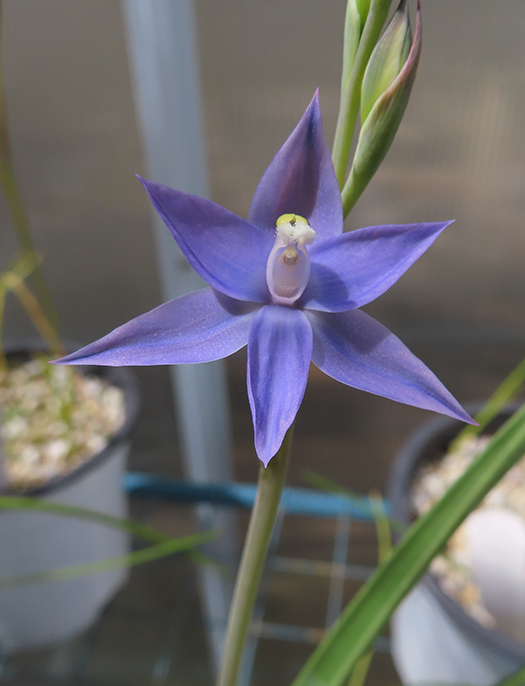 |
Thelymitra glaucophylla 'Royal Blue'Or maybe Thel. nuda... |
|
 |
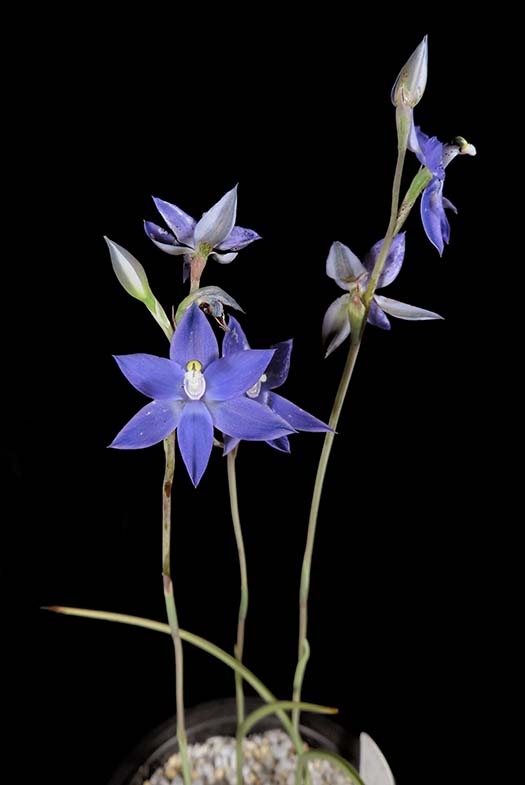 |
Thelymitra nuda 'Royal Blue' |
|
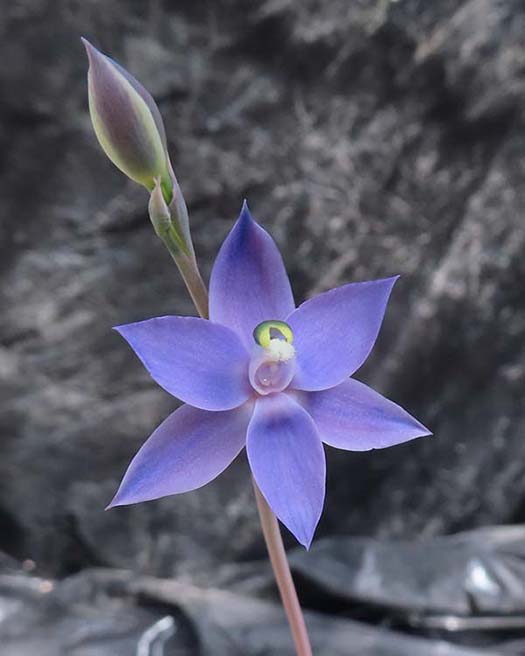 Thelymitra gramminea |
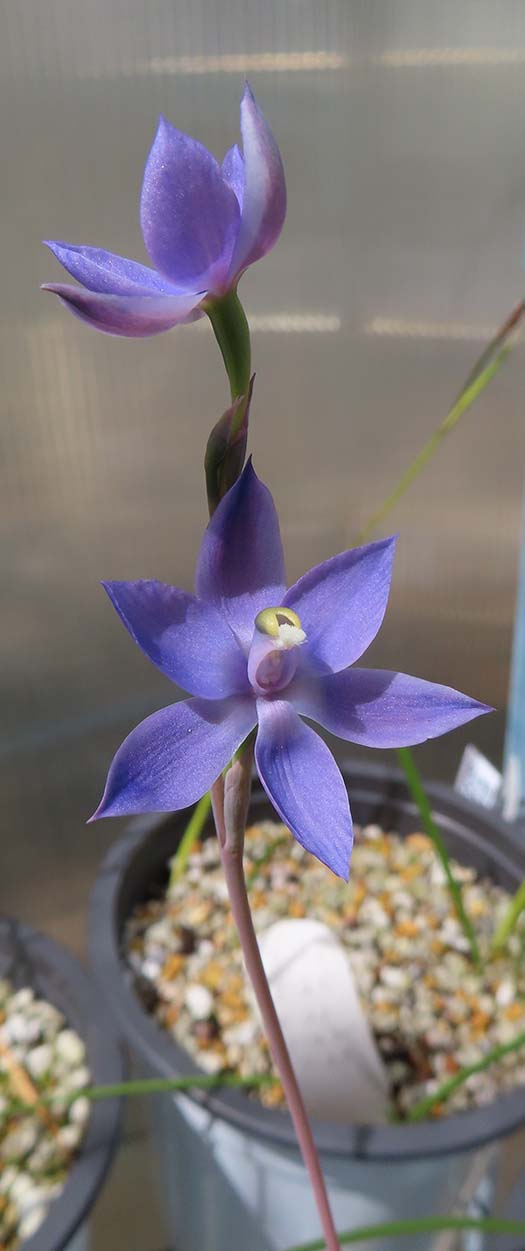 |
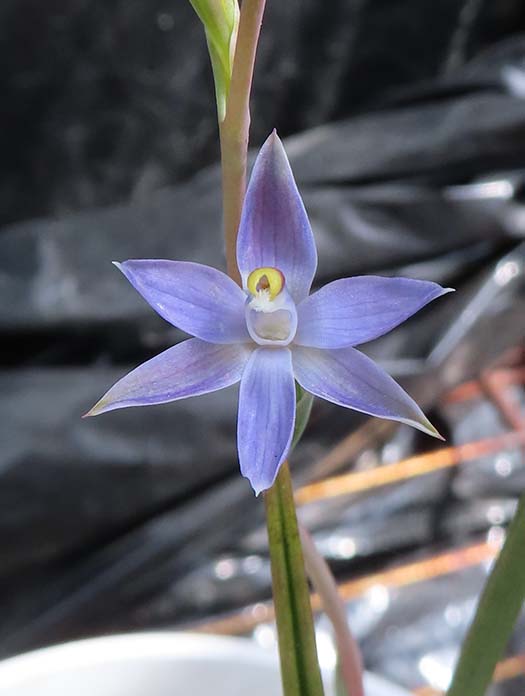
Thelymitra paucifloraThis is a little one, flowers only about 1/2 inch. These also seem to have a tendency to self-pollinate. |
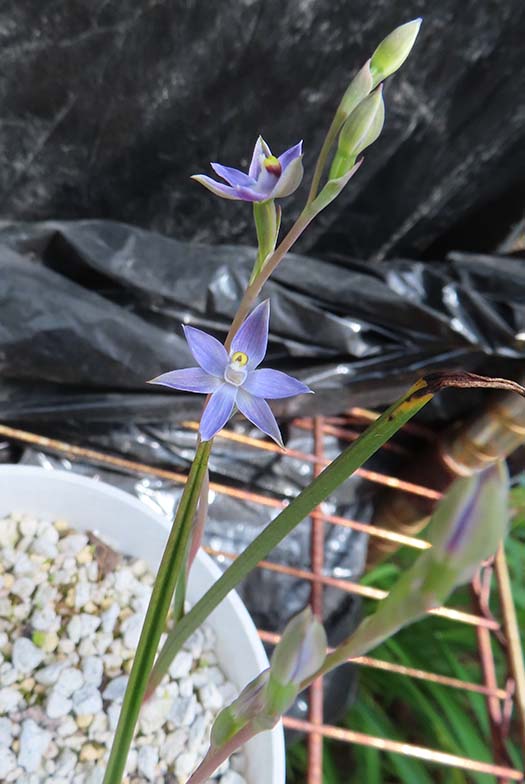 |
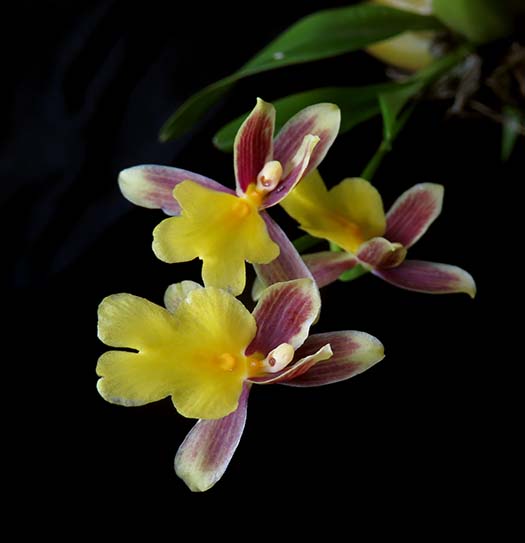
Oncidium ghiesbrechtianum
|
|
In the greenhouse... |
|

Polystachya paniculataFrom central and west Africa, elevations 200-1800 m. It is possible that it could grow cooler due to the upper end of its elevation range, but it is doing well in the greenhouse so that is where it will stay. The contrast between the bright orange flowers and the bright green stem is dramatic. |
|
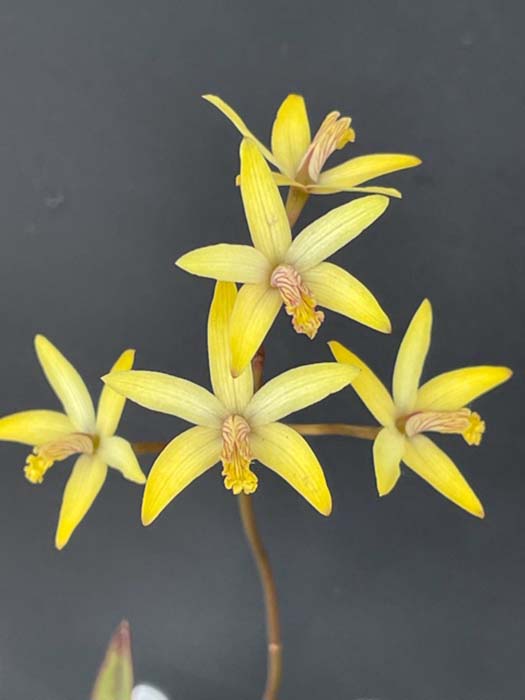
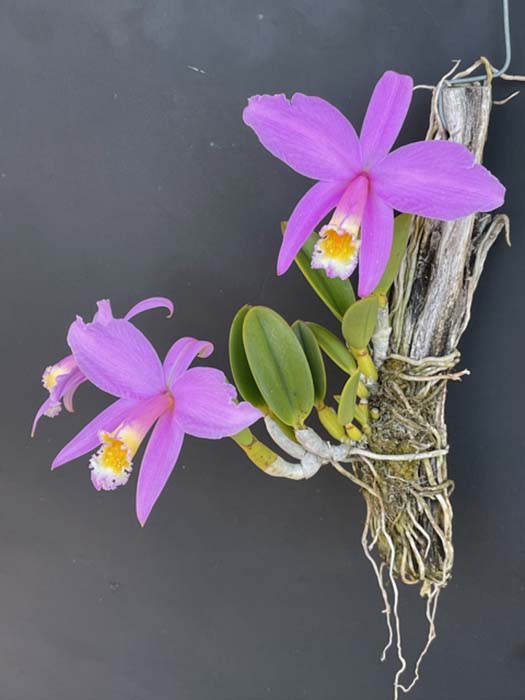
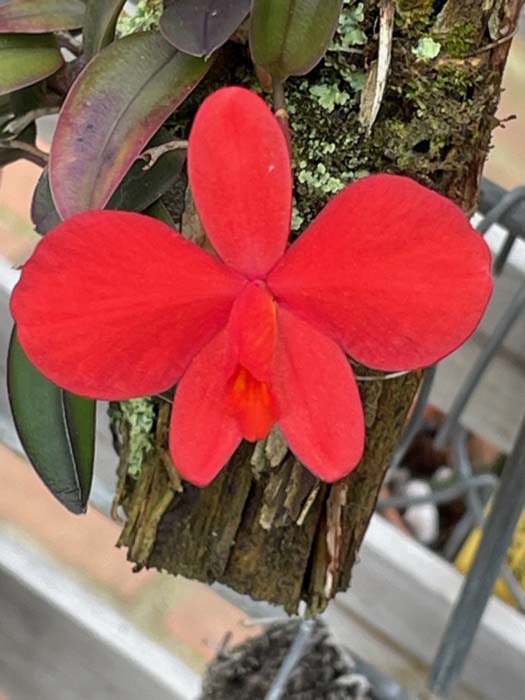

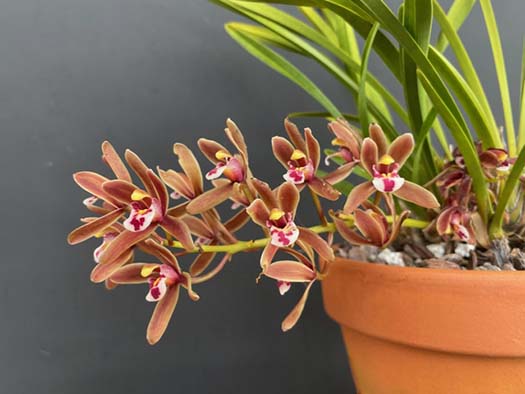
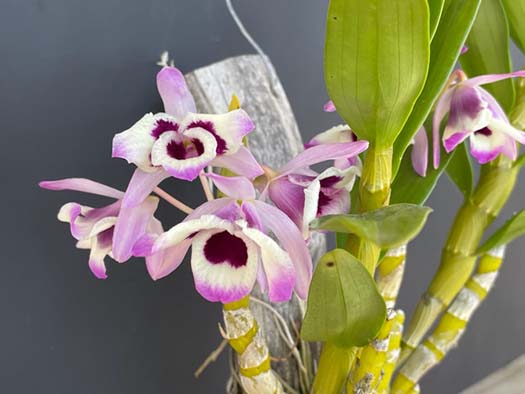

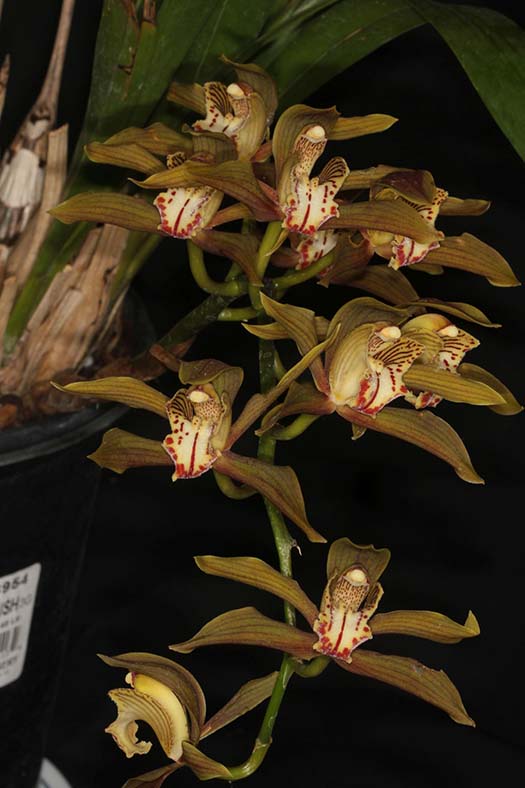
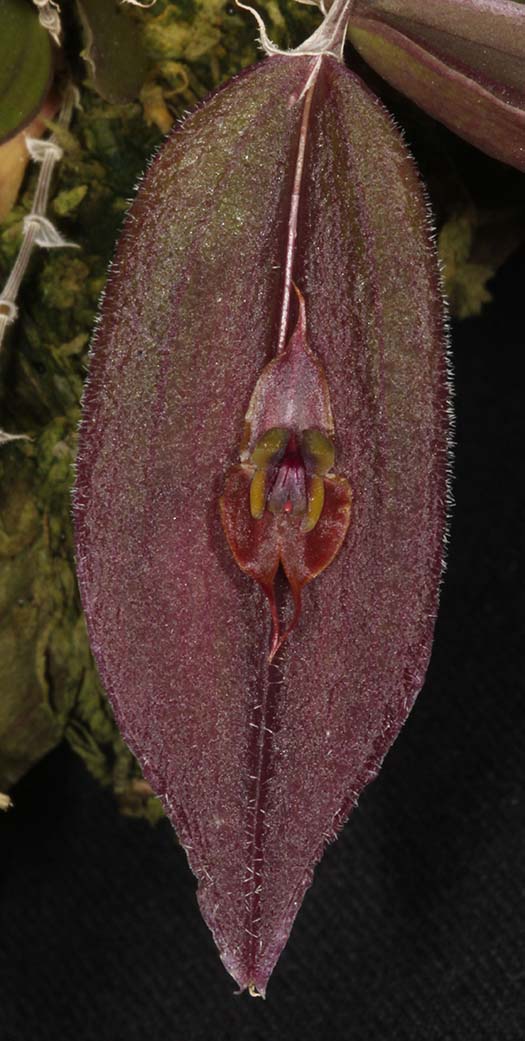

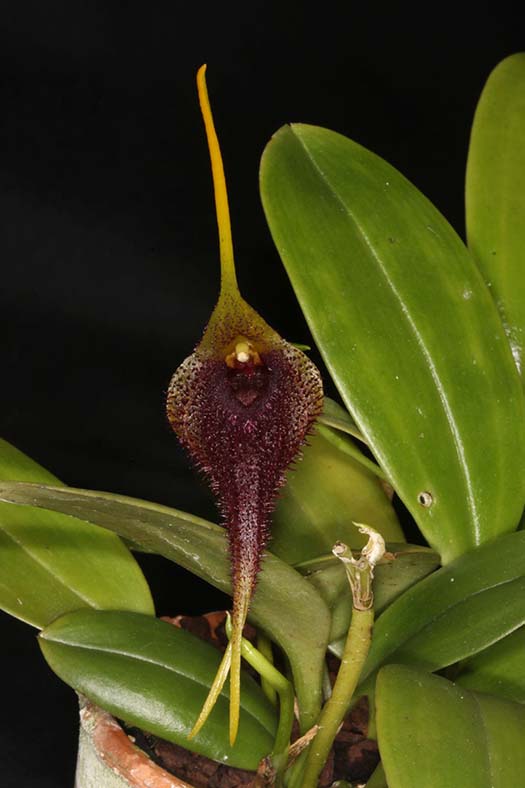
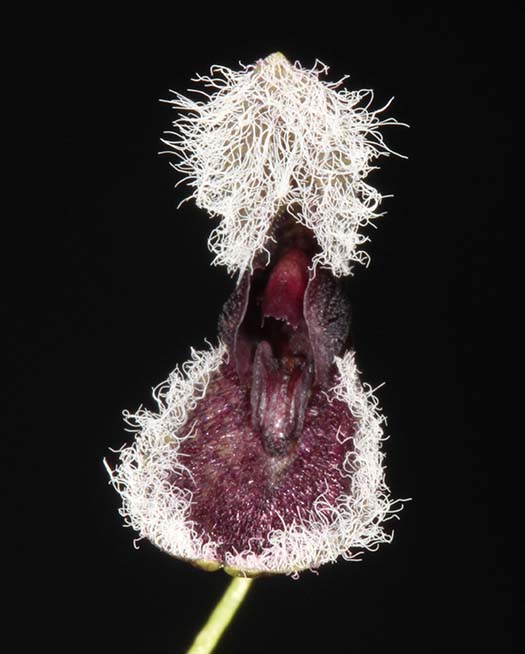
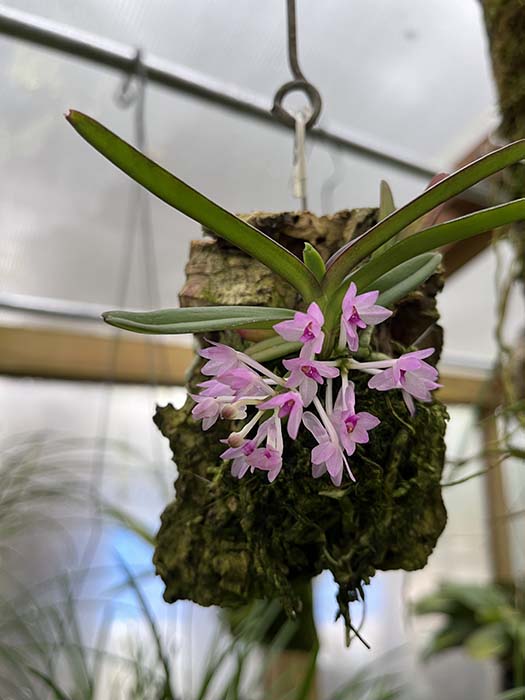
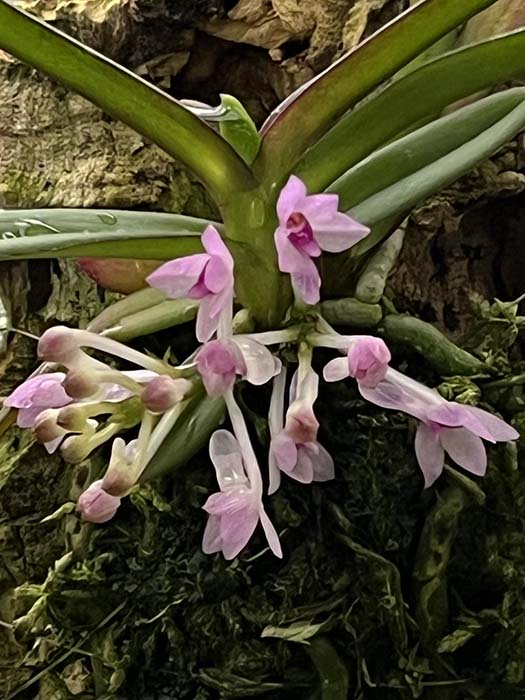



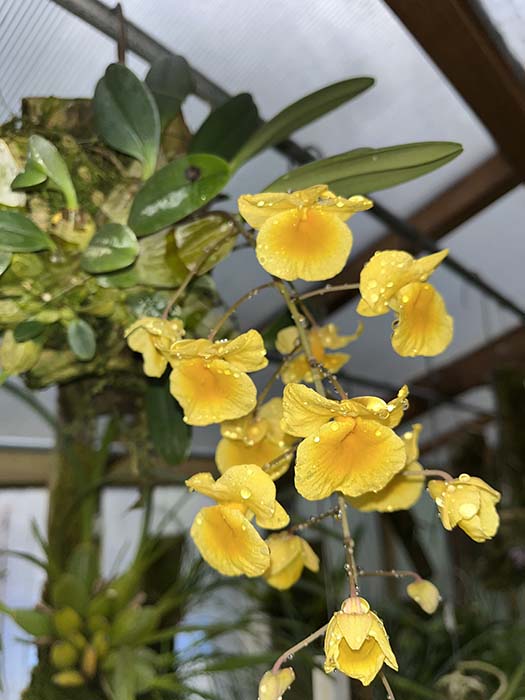
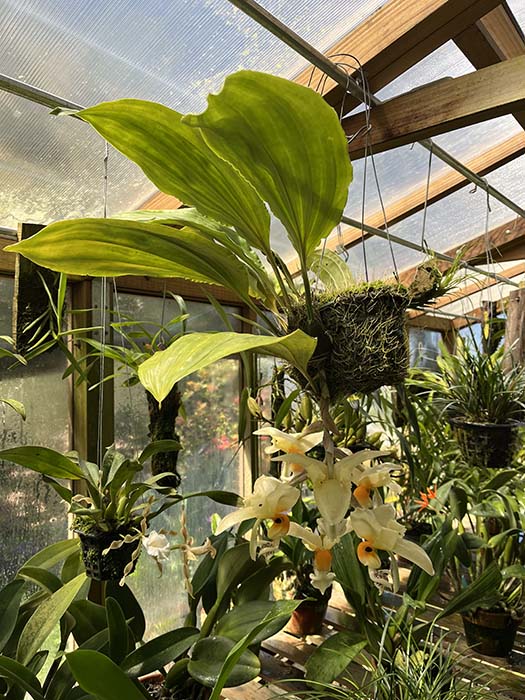

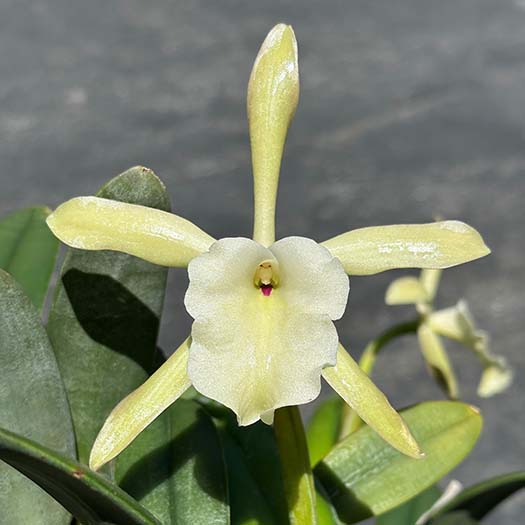
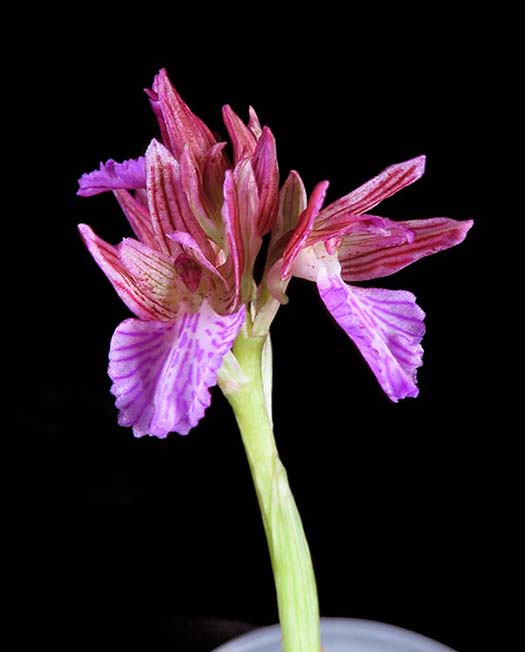
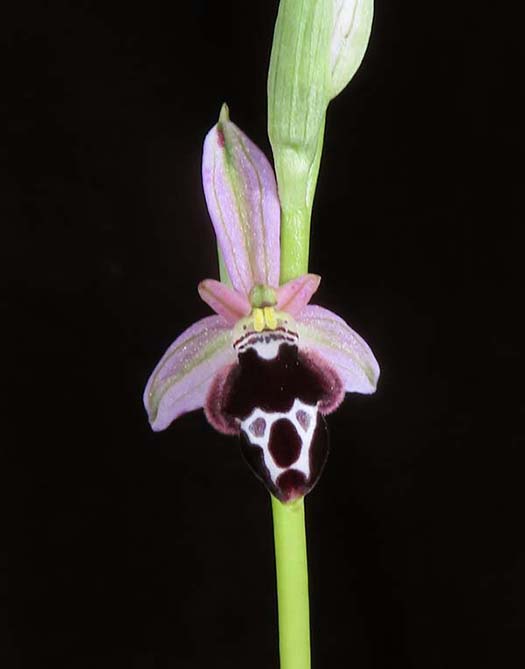 Ophrys sp.
Ophrys sp.